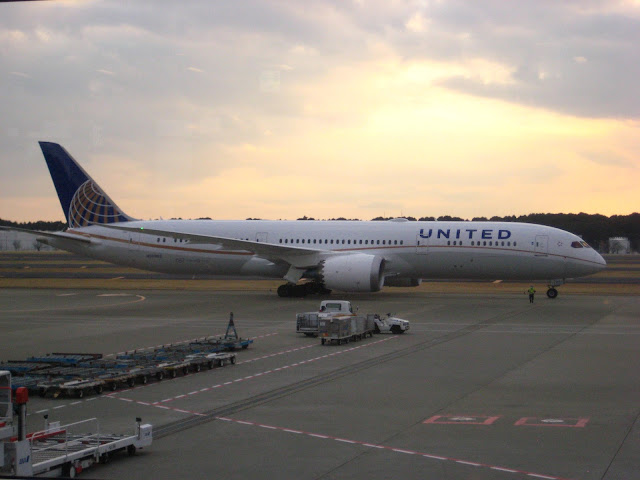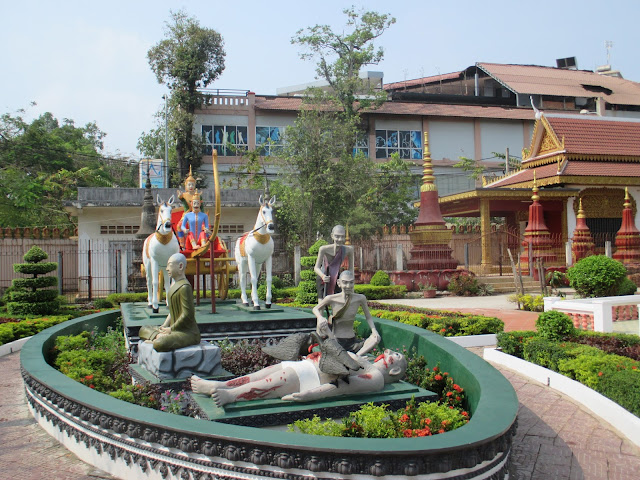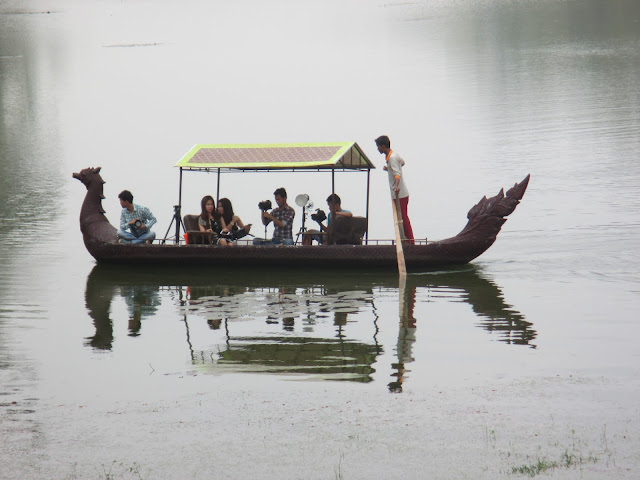Tuesday, March 8.
We were thinking
about revisiting Angkor Wat, but decided to stop at a small temple we hadn’t
seen and then go back to Wat Bayon in Angkor Thom.
The little temple is
made of brick, and was built by subjects of the kingdom, and not under the
direction of the king. It’s off by itself and made of brick. The royal temples
are stone.
The Lonely Planet
guide book, which exaggerates everything, said the temple, Prasat Kravan, has
extraordinary wall carvings.
The wat is small,
five towers rising from a base that may be five feet or six above ground. Three
towers have had their lotus flower tops lopped off. The steps aren’t many, but
they are steep and narrow.
The central tower has
three reliefs of Vishnu. One looks like he’s dancing, but I read it refers to a
story about how he reclaimed the world from the devil.
He took the
appearance of a small monk and asked the devil for a plot of ground where he
could meditate. Only as wide as three paces, he said.
When the devil
agreed, Vishnu assumed such enormous size that he strode across the entire
universe in three steps to claim it all.
The right hand tower
has bas-reliefs of Vishnu’s consort, Lakshmi.
The carvings in the
other three towers have been removed. Or lost.
The carvings were
lovely, but I don’t think they are superior or even radically different from
those at Bayon, which was built about 250 years later than the brick temple.
Of course, Lonely
Planet also told us that Angkor Wat was going to make our spines tingle like no
other sight could do. Turns out, it wasn’t a tingle at all, just sweat.
They say if you can
only visit two temples, see Angkor Wat and Bayon. As far as I can see, you go
to Angkor Wat to cross it off your to-do list. You go to Bayon, and Ta Prohm
too, because they are fantastic.
The visit to Prasat
Kravan brought us to the Angkor Thom about an hour later than we got there on
Monday. At eight on Monday, it looked like Disney World with all the tourists.
At nine on Tuesday, it looked like Disney World on a holiday weekend.
We climbed to the
second and third levels, and even looked for the resident monkey, but it seems
the crowds were so thick they intimidated even him. (We did see the monkey clan
on the way over. They were out running along the Angkor Wat moat.)
I wanted to study the
bas-reliefs carved into the outer walls of the temple. Many of them deal with
battles between the Khmer and the Chams. We overheard a guide explaining to a
tour group that the Khmer were identified by their long earlobes, like the
Buddha’s. The Chams, who were a Chinese people, had small ears.
OK. Flat noses, long
earlobes—we’re picking up a few points on classical Khmer art.
One of the scenes is
a sea battle on Lake Tonle Sap that continues onshore until the Chams are
defeated.
All along the bottom
of the panels are people onshore doing common everyday things while the battle
rages. Some are hunting, others farming. Some, the books said, are picking lice
from each other’s heads, and there is a woman giving birth. Not sure how much
license the writer took with those last two interpretations.
Other panels show the
Chams winning and sacking a city. Angkor Thom, which means “Great Capital City,”
was built as a new capital after the final defeat of the Chams. It was
eventually abandoned because it was too close to the frontier with the Thais.
The Khmer moved their capital from Angkor Thom to Phnom Penh.
There may have been
an instance of Bowdlerism in one panel, which according to Lonely Planet, shows
linga worship. The center of the panel has been replaced by modern, plain
blocks. Could the linga being revered have been too graphic? Was it removed to
protect public morals?
We were close to
passing out in the heat. We were hungry and too hot to eat anything. So we said
good day to Angkor Thom and took shelter back at the hotel, as usual in the
afternoon. We did venture out for lunch. We went to a small place on Pub Street
called Khmer Idea, where I had a curry made with pork, pineapple, and coconut
milk.
The red chilis in the
curry were uncut so the stew wasn’t overly spicy. I bit one, of course, and
went through a lot of beer and white rice to ease the burn.
Joanna had a dish of
stir-fried pumpkin that was originally supposed to include chicken, but she
asked to have it without meat. No problem with that.
She asked to have it
made without black pepper or chili. As often happens here, she was assured that
too would be no problem. Apparently the kitchen didn’t get the message. We sent
the dish back, and they tamed it the second time around.
We hid out in the
hotel after that until almost seven. I wanted to look at the menu at a bar
called the Red Piano—mainly because they advertise Belgian beers. Not on draft,
but that’s OK, because Duvel and Chimay (I had one of each) are bottle
conditioned.
Either I have totally
forgotten how Chimay tastes or, like the Guinness, there is a wretched local
version sold here. Chimay is a very strong ale, and it may include clove in the
brewing. Either clove or a blend of hops that create a surprisingly clove-like hint
of flavor.
In the Red Piano,
though, Chimay was thick, syrupy, and sweet—the same as the export Guinness
stout. Duvel, on the other hand, was the real thing. So that gives you two brews
to avoid if you’re over here.
Joanna and I shared a
local steak—again, tough but tasty. We had it with French fries (what else in a
Belgian-themed bar?) and a sauce made of mushroom, mustard, and onion.
Absolutely delicious.
A man sitting at the
next table asked me about the Duvel. Is it German? No, Belgian.
We started to chat,
and his wife struck up a conversation with Joanna at the same time.
His name is Tom. He
and Sharon are originally from the U.K. now living in Australia. They’re on a
holiday in Cambodia and are about to go to Hong Kong for a couple of months,
apparently on business.
I forget how it got
started, but he tried to explain rugby to me. I had been watching a game on TV
at the U.N. bar a few weeks ago. The ball carrier was knocked down, and players
from his team and the rival team piled up on him.
That didn’t end the
play. He was allowed to hand off the ball from under that heap of humanity to a
teammate, who continued the run downfield. That guy went down, handed off the
ball, and they were off and running yet again.
OK. So how does a
play end? It’s simple in American rules football, a ball-carrier’s knee touches
the ground and the whistle blows. Tom tried to explain, but I still didn’t get
it.
Joanna and I walked
around the block a few times, ate some gelato, and went home.
Wednesday, March 9.
We’re starting to get
used to rising in the morning. We were out by 8 o’clock to walk before the day
heated up.
We went to Kings Road
for breakfast. The Blue Pumpkin was open, but that was the outfit with the
disgusting food that ripped us off at the airport, so I was having none of
that. We settled on a Cambodian restaurant called Rohatt.
Not bad. The coffee
was OK. Joanna had a bowl that included fruit, yogurt, muesli, milk, and honey.
I had ordered pancakes and fruit. When it came, I was surprised to find that it
was served with maple syrup. I had expected honey, which is all right, but I
prefer the maple flavor.
We passed the market
stalls and stopped in one with fantastic wood carvings—almost life-size figures
of Chinese sages, 6- and 8-foot-high polished tree trunks with bas-reliefs, and
lots of other things you won’t fit into your luggage. So I guess there is a
market for that here.
Joanna was curious
about beads made of a scented wood called agarwood. She didn’t find anything
she wanted, but maybe she will later.
We strolled along the
Siem Reap River, not anywhere near as picturesque as the Riverfront in Phnom
Penh. There were a few restaurants and other small businesses, which appeared
to be run out of private homes. Many of the buildings were unpainted wood
structures with corrugated metal roofs.
We found a bridge
over a small dam that brought us back to our original side of the river. We
followed the river on that side and came to a place whose name is beyond me:
Preah Promreath Pagoda, which dates to the late 14th century.
It includes a
cemetery full of spirit houses for the dead. It also showcases a life-size
sculpture group illustrating Siddhartha Gautama’s initiation into the way of
the world, or “The Four Great Sights.”
He had lived a
sheltered life, and wanted to see more to the world. He went out with his
charioteer. The grouping shows him in front of a sick man, an old man, and a
corpse being eaten by vultures.
It was his first
glimpse of illness, old age, and death. He had never seen or heard of them
before. He got a little rattled when his charioteer explained that anyone can
get sick, and that everyone will grow old and die.
On his way home, he
saw a sage who had found peace by renouncing the world. The experience inspired
him to leave his home and family and seek enlightenment.
There was also a
replica of a boat carrying a monk.
Inside the temple
there is a gallery of vividly colored wall panels depicting episodes from the
Buddha’s life, including a representation of the Four Great Sights, his farewell to his
sleeping family (another frequently painted scene), his hair-cutting and
renunciation, and enlightenment. One panel may show Makha Bucha Day, the Buddha
sitting with crowds of disciples around him.
One panel may be a
story borrowed from the Gospel of Luke. It shows a woman drying the Buddha’s
feet with her hair. Or maybe the gospel writer had heard the story about the
Buddha.
[Editor’s note: Harry
learned later that the woman in this case is Yasodhara, Gautama’s wife, whose
tears washed his feet when he returned as an enlightened being. In St. Luke,
the woman is an unidentified “sinner,” who brings a ritual ointment and also
washes Jesus’ feet with her tears.
We came across a sign
that explained the boat replica out front.
More than 500 years
ago, a monk from this wat used to travel by boat to beg at a distant village.
Even though it was a long trip, when he returned the rice in his bowl was still
fresh.
One day, sharks broke
his boat in two on the lake. He was in the bow, which miraculously did not
sink, but instead raced back up the Siem Reap River so fast that it couldn’t
fill with water and so returned him safely home.
The monks used that
half of the boat to build a reclining Buddha.
Joanna and I found
the reclining Buddha in the temple. The figure from the shoulders to the ankles
is covered by a shroud. I went down when no one was near and touched it. It
could be the hull of boat under there, but I don’t know.
Joanna found a pole
with baskets of fruit attached to each end. We’ve seen people using similar
devices on the street. She hoisted it onto her shoulder for a photo.
It was still early
when we stepped outside, but we were already sweating. I had taken only one cup
of coffee and wanted more caffeine, so we headed toward the market area near
Pub Street.
We stopped at a cafe
where I discovered something new. The menu listed watermelon juice (always a
good thirst quencher) and “Buddha fruit juice.” What’s that? So I ordered a
glass of it in addition to a pot of black tea.
Buddha fruit juice
has a strange flavor, and we asked the waiter about it. He brought a couple of
examples to the table. One was whole. It looked like a kiwi, but was so light
when I picked it up that it felt hollow. He also had pieces that showed the
seeds.
The juice is actually
an infusion. The skin and seeds of the Buddha fruit are steeped in water for an
hour and a half to make it. One Buddha fruit will flavor two liters of water.
On our way to the
hotel, we stumbled on the market stalls where we bought Joanna’s saffron
umbrella. They had more, so I bought her another, which I managed not to bend
out of shape.
I have no idea how to
get them home. They don’t even fit into my monster suitcase. But hey, people
check skis on airplanes. I’m sure we’ll work out something.
We’ll be going out
for dinner soon. I wonder what kind of beer I’ll find.
I’m starting to have
some small affection for Siem Reap that I do not feel for Phnom Penh.
In other words, so
far, so good.
Be well, all.
Harry
























